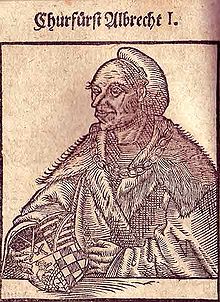Albert I, Duke of Saxony
| Albert I, Duke of Saxony | |
|---|---|

Woodcut of Albert I c. 1550
|
|
| Spouse(s) |
Agnes of Austria Agnes of Thuringia Helene of Brunswick-Lüneburg |
| Noble family | House of Ascania |
| Father | Bernard III, Duke of Saxony |
| Mother | Brigitte of Denmark |
| Born | c. 1175 |
| Died | 7 October 1260 |
| Buried | Lehnin Abbey |
Albert I (German: Albrecht I.) (c. 1175 – 7 October 1260) was a Duke of Saxony, Angria, and Westphalia; Lord of Nordalbingia; Count of Anhalt; and Prince-elector and Archmarshal of the Holy Roman Empire. Even though his grandfather Albert the Bear had held the Saxon dukedom between 1138 and 1142, this Albert is counted as the first.
A member of the House of Ascania, Albert was a younger son of Bernard III, Duke of Saxony, and Brigitte of Denmark, daughter of Canute V of Denmark. After his father's death in 1212, the surviving sons of the late duke divided his lands according to the laws of the House of Ascania: The elder Henry received Anhalt and the younger Albert the Saxon duchy. Albert supported Otto IV, Holy Roman Emperor, in his wars against the Hohenstaufen.
In 1218 Albert's maternal uncle Prince-Archbishop Valdemar of Denmark, who had been deposed from his Prince-Archbishopric of Bremen, found refuge in Saxony, before he joined the Loccum Abbey as monk.
On 22 July 1227 Albert I asserted as fellow victor in the Battle of Bornhöved, commanding the Holy Roman left flank, his earlier disputed rank as liege lord of the Counts of Schauenburg and Holstein, a privilege, however, lost by his successor John V in 1474. After Bornhöved Albert reinforced and extended his fortress and castle in Lauenburg upon Elbe, which his father Bernard had erected in 1182.
...
Wikipedia
